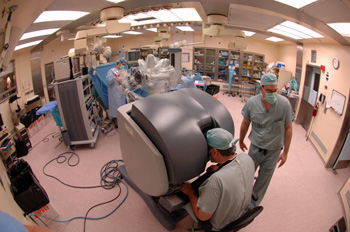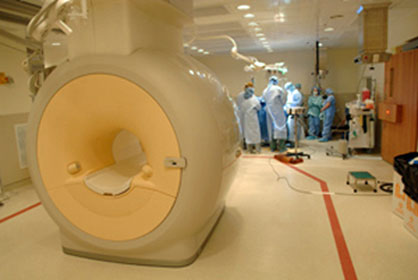Intra-operative Magnetic Resonance Imaging (IMRI) and the Robotic Surgery System supported by the Department of Perioperative Medicine
The Department of Perioperative Medicine (DPM) has two state of the art technological resources available to support the mission of the NIH Clinical Center (CC) research protocols, said Andrew Mannes, MD ME, chief of the Clinical Center's Department of Perioperative Medicine.
—The Da Vinci Robotic surgery system and the Intra-Operative Magnetic Resonance Imaging suite.

In 2005 The National Cancer Institute and the CC acquired the robotic surgery system. It is currently used for prostate and kidney cancer surgery, although investigators are considering additional applications.
The Da Vinci robot is a "tremendous leap forward and advancement in surgery", said Dr. Peter Pinto, one of the urology surgeon at NCI's Urologic Oncology Branch in the Center for Cancer Research, "especially for traditional radical prostatectomies—the removal of the entire prostate gland and pelvic lymph nodes. The surgery without the robot requires an incision from belly button to the pubic bone, with two or three urologic surgeons' hands inside the patient. A radical prostatectomy with this robotic technology uses the same instruments, only they're longer and function as an extension of the surgeon. During a surgery, Dr. Pinto sits on the other side of the suite from the patient, with his head tucked into a large console and his hands grasping controls that translate how he moves the wristed surgical instruments. The robotic unit provides a super-magnified, three-dimensional image of the patient's abdomen so the procedure becomes, in effect, a minimally invasive laparoscopic surgery performed with small "keyhole" incisions in the lower abdomen.
Laparoscopic surgeries use two-dimensional images and have no depth. The CC's system allows for 3D viewing in the console, which emulates the open technique. The camera also magnifies the view to 10 to 15 times greater and can come within millimeters of the tissues being examined—something a surgeon could not do with the naked eye. Pinto's protocols are exploring the benefits of the relatively new technology by incorporating it into the operating room and tracking patient quality-of-life outcomes. "Urologic surgeons at large are offering robotic-assisted radical prostatectomies to patients across the country, so we thought it should be examined critically here", Dr. Pinto said. There is a trend toward improved patient outcomes with laparoscopic techniques in a few categories: pain and suffering after surgery, blood loss, and return-to-work rates, and some studies show the same benefits with robotic technology, according to Dr. Pinto. To track patient quality-of-life outcomes over time, Dr. Pinto's patients respond to a validated questionnaire before surgery and one, three, six, and 12 months after surgery.
Dr. Pinto Urology team also accomplished the first robotic-assisted Laparoscopic Partial Nephrectomy (LPN) in a patient with multiple renal tumors. The CC and NCI run protocols for patients with inherited forms of kidney cancers, which can produce multiple tumors in one or both kidneys in a lifetime. Instead of removing the kidneys, which would require dialysis and reduce quality and length of life, most surgeons remove tumors but leave the kidney intact through open surgery, which often requires removing the 11th rib and muscle.
The CC is one of the few places across the country offering LPN, which requires extensive training and surgical skills, but also provides the benefits of a minimally invasive procedure. However, it is still difficult to create a bloodless operating space and to remove multiple tumors with LPN. With a robotic-assisted procedure, Pinto could suture the highly vascular kidney faster to control bleeding and removed three tumors from the patient's kidney.
A Magnet in the Department of Perioperative Medicine – Operating Room
The Intra-Operative Magnetic Resonance Imaging (IMRI) suite represents a collaborative effort that the Clinical Center (CC), National Cancer Institute, and NINDS opened in 2005. It provides real-time imaging during surgery and a display of current and pre-operative images using three-dimensional and virtual reality technology. Fewer than 20 facilities nationwide have high-field interventional IMRIs similar to the CC's. It has a 1.5 Tesla magnet that allows staff to obtain better images.

One of the unique uses for CC's IMRI is to track the infusion of solutions of enzymes and chemotherapeutic agents into the brain to treat metabolic diseases and brain tumors. Drs. Edward Oldfield, chief of neurosurgery at NINDS; Russell Lonser, staff clinician in the clinical neurosurgical section at NINDS; and ORS Division of Bioengineering and Physical Science bioengineers Robert Dedrick and Paul Morrison developed the infusion technology and brought it to the bedside in the CC for adult brain tumor patients and pediatric patients with Gaucher disease and brain stem gliomas. Dye is mixed with the medication so that it will show up in the machine's images of the brain and allow staff delivering the agent to watch how it travels. Unlike a regular MRI that is performed periodically, the IMRI allows almost continuous scanning so the surgeons can track in real-time the distribution of the therapy.
The IMRI also allows surgeons to move seamlessly between operating and imaging, visualizing tumors before, during, and after an operation. For example, Dr. John Heiss, NINDS staff neurosurgeon, uses the IMRI during craniotomies, in which the skull is opened to remove tumors located close to the parts of the brain that allows one to understand speech. Heiss uses the IMRI to assist in approaching the tumor, pinpointing its border and nearby structures, monitoring how much tumor remains throughout surgery, confirming the removal of all abnormal tissue, and identifying other problems, such as blood clots, that must be addressed before ending the procedure. With the IMRI, surgeons can collect the information quickly, efficiently, and precisely during one operation rather than a succession of surgeries.
In addition to real-time tracking of therapies and tumor imaging, NIH researchers apply the IMRI to improving the effectiveness of other targeted therapies, such as radiation. For example, by imaging the upper abdomen and creating IMRI-based movies, physicians can see how the pancreas moves with respiration and can coach patients on how to breathe so their organs stay in the radiation field. Dr. Anurag Singh, an NCI staff clinician, currently uses the IMRI to study bowel and pancreas motion and target breast biopsies. "The nice thing about IMRI is that you don't have any radiation, so patients can receive it over and over again, Singh said. The IMRI is valuable for populations, such as children, who should minimize radiation exposure throughout their treatment. According to Singh, the CC is unique because it is "one of the few places where you can get a magnet in the operating room.

